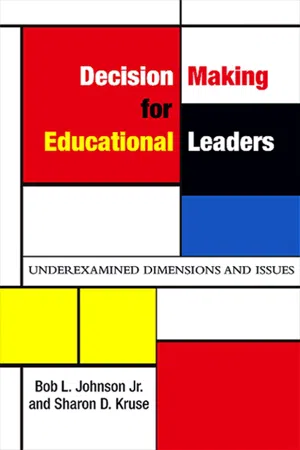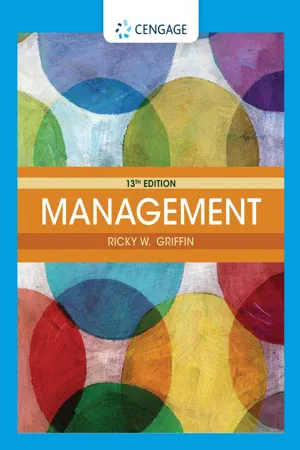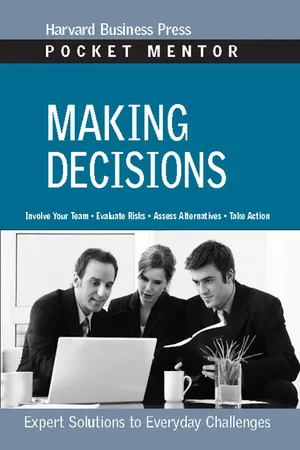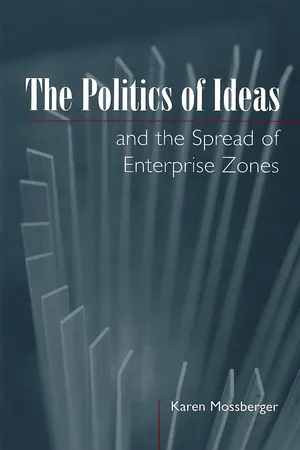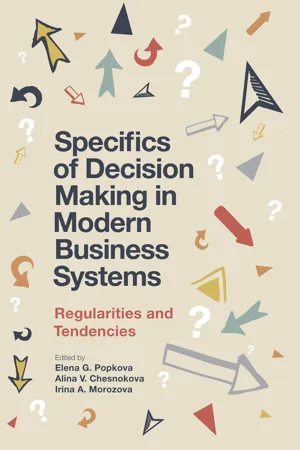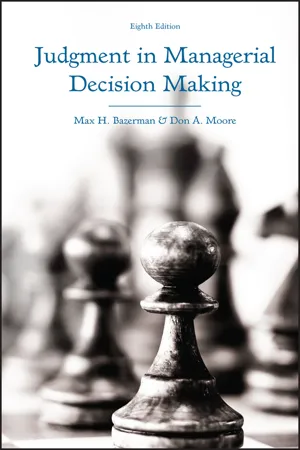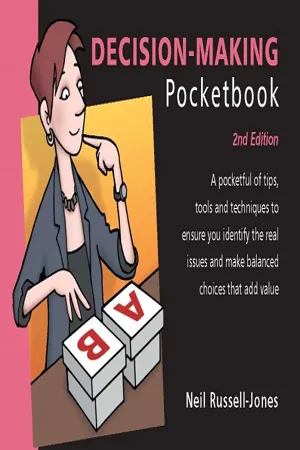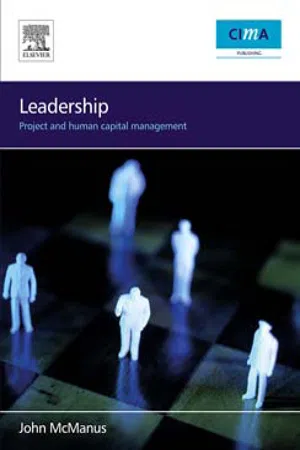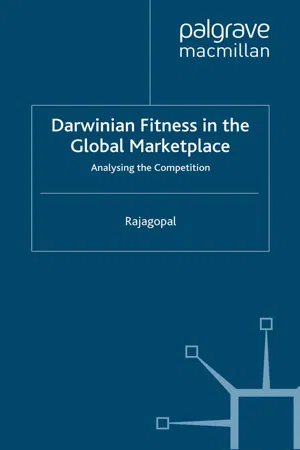Business
Decision Making Model
A decision-making model in business refers to a structured approach used to make choices and solve problems. It typically involves identifying the decision to be made, gathering relevant information, evaluating alternatives, making a decision, and implementing and monitoring the decision's outcomes. This systematic process helps businesses make informed and effective decisions.
Written by Perlego with AI-assistance
Related key terms
1 of 5
12 Key excerpts on "Decision Making Model"
- eBook - PDF
- Stephen Cohen, Michael Schwartz, Howard Harris, Stephen Cohen, Michael Schwartz, Howard Harris(Authors)
- 2013(Publication Date)
- Emerald Group Publishing Limited(Publisher)
Some commentators in literature have shown that decision making should be a process of rational decisions in making choices that consistently maximise value within the specified constraints ( Harrison, 1981 , pp. 53–57, 81–93; Robbins et al., 2001 , pp. 162– 163). Johnson, Scholes, and Whittington (2005) show that strategic development is built on the principles that managers are rational decision makers and that they should be taking decisions about how to optimise economic performance of their organisations. Effectiveness of an organisa-tion is dependent on managers being able to make appropriate decisions ( Horngren et al., 2004 , pp. 306–307; Langefield-Smith, Thorns, & Hilton, 2003 , p. 878). The most common Decision Making Model in management is the Rational Model ( Harrison, 1981 , pp. 53–57; Johnson et al., 2005 , pp. 41–42; Langefield-Smith et al., 2003 , p. 880). A compilation (see Table 1) of the Rational Model of decision making techniques used in some areas of man-agement such as quality control, finance, accounting, occupational health and safety (OH&S), human resource management (HRM) and corporate strategy shows a common process within organisations. From Table 1, we can consolidate the process to: 1. Defining, identifying, clarifying, establishing or perceiving the problem 2. Identifying or measuring the decision criteria, risks, issues of courses of action 3. Analysing, improving, collecting, comparing, specifying, assessing, evaluating, allocating, and understanding costs and benefits, solutions, alternatives, possible outcomes, risks and capabilities 4. Implementing, selecting, treating, reasoning, choosing the decision and course of action, the best alternative method, a core strategy, and making the decision or strategy work. SUNIL SAVUR 140 Table 1. Rational Models of Decision Making Techniques in Some Areas of Management. - eBook - PDF
Decision Making for Educational Leaders
Underexamined Dimensions and Issues
- Bob L. Johnson Jr., Sharon D. Kruse, Bob L. Johnson, Jr.(Authors)
- 2012(Publication Date)
- SUNY Press(Publisher)
49 Organization as Context: Decision Making in Educational Organizations CHAPTER THREE Decision making is a cognitive process that guides human thought and action. Regardless of when, where or by whom a decision is made, a number of common elements define this process. Driven by the need to eliminate the dissonance created by a problem or perceived inconsistency, decision making consists of the following cognitive activities: data search, data collection, data analysis, data synthesis, and multiple inferential leaps (Dewey, 1933, 1938). These activities occur in contexts defined by varying levels of uncertainty and risk. More often than not, the amount of information available to make a deci- sion is incomplete. The uncertainty this state of affairs creates has implications for the entire decision-making process. For example, decision preferences may be known or unknown. If decision preferences are unknown, the decision maker lacks an organizing referent for decision activities. If decision preferences are known, the decision maker often encounters multiple means or alternatives for realizing these preferences. Incomplete knowledge of how each alternative is logically linked to decision preferences makes the prioritization of alterna- tives problematic. The various levels of detail and different amounts of information at the disposal of the decision maker can be mind boggling. Whether the decision is made by a police officer patrolling an Atlanta neighborhood, a consumer con- templating the purchase of a new vehicle in upstate New York, or a principal in rural Wyoming, these and other common elements define the decision-making process. Yet in spite of the potential complexities these present, sound deci- sions are made daily with little or no thought given to the mental processes identified above. - eBook - PDF
- Ricky Griffin(Author)
- 2021(Publication Date)
- Cengage Learning EMEA(Publisher)
Enhanced communication of the decision may result. Better decisions generally emerge. The process takes longer than individual decision making, so it is costlier. Compromise decisions resulting from indecisiveness may emerge. One person may dominate the group. Groupthink may occur. Copyright 2022 Cengage Learning. All Rights Reserved. May not be copied, scanned, or duplicated, in whole or in part. Due to electronic rights, some third party content may be suppressed from the eBook and/or eChapter(s). Editorial review has deemed that any suppressed content does not materially affect the overall learning experience. Cengage Learning reserves the right to remove additional content at any time if subsequent rights restrictions require it. 236 SUMMARY OF LEARNING OUTCOMES AND KEY POINTS 8-1. Discuss the meaning of decision making, types of decisions, and decision-making conditions. • Decision making is the act of choosing one alternative from among a set of alternatives. • The decision-making process includes recognizing and defining the nature of a decision situation, identifying alternatives, choosing the “best” alternative, and putting it into practice. • Two common types of decisions are programmed and nonprogrammed. • Decisions may be made under states of certainty, risk, or uncertainty. 8-2. Discuss rational perspectives on decision making, including the steps in rational decision making. • Rational perspectives on decision making rest on the classical model. • This model assumes that managers have complete information and that they will behave rationally. The primary steps in rational decision making are: • Recognizing and defining the situation • Identifying alternatives • Evaluating alternatives • Selecting the best alternative • Implementing the chosen alternative • Following up and evaluating the effectiveness of the alternative after it is implemented. 8-3. Describe the behavioral aspects of decision making. - eBook - PDF
Making Decisions
Expert Solutions to Everyday Challenges
- (Author)
- 2008(Publication Date)
- Harvard Business Review Press(Publisher)
Making Decisions: The Basics What Is Decision Making? 3 4 Making Decisions A s a manager, you are faced with decisions every day. Some decisions are straightforward, such as deciding which team member to assign to a specific project. Others are more complex, such as selecting a new vendor or deciding to dis-continue a product due to weak sales. Many managers tend to view decision making as an event—a choice to be made at a single point in time, usually by an individ-ual or a small group. In reality, however, significant decisions are seldom made in the moment by one manager or in one meeting. Simply put, decision making is a social or group process that un-folds over time. “Effective executives know that decision making has its own systemic process and its own clearly defined elements.” —Peter Drucker Decision making as a group process Important decisions, such as changing the strategic direction of a group or hiring a new manager, typically require time and input from many individuals and sources of information throughout an organization. Hence, decision making can more accurately be viewed as a group process . Managers who recognize decision making as a group process increase their likelihood of making more effective decisions. Why? By taking time, they are able to identify and assess the issues asso-ciated with making the decision. By involving others, they weigh different perspectives and deepen the discussion. Perhaps most important, taking a process-driven approach is more likely to lead to broader acceptance of the decision—which in turn leads to more effective implementation. Making decisions: eight steps We can think of the decision-making process as consisting of eight steps: 1. - eBook - PDF
Project Based Problem Solving and Decision Making
A Guide for Project Managers
- Harold Kerzner(Author)
- 2023(Publication Date)
- Wiley(Publisher)
Decisions do not deal with the past; they deal with the present and the future. A decision-maker needs to be creative and skillful and to operate from an experience base in using information in arriving at decisions. There are several models that can be used. Many of the steps are similar to the steps used in setting up the problem-solving process. Steps that are common to many of these models include: ● Determine the framework of the problem or opportunity that requires a decision ● Send out an agenda identifying the purpose of the decision-making meeting and the expected outcome, including the expected timing for the decision ● Ask the team to come to the meeting with alternative solutions, if possible ● Perform a root cause analysis of the problem to make sure everyone under- stands why a decision is necessary, and the impact if a decision is not made ● Collect the appropriate facts and assumptions bearing on the decision ● Analyze the facts and assumptions that impact the problem or opportunity ● Develop alternatives that are viable in dealing with the decision ● Analyze the alternatives based on an assessment of the strengths (benefits) and weaknesses (costs) relative to existing organizational purposes (mission, objec- tives, goals, and strategies) ● Select the alternative that has the best fit with organizational purposes ● Delineation of a plan of action on how the decision will be implemented. These steps formulate the decision-making process carried out by managers and professionals. These steps are found with varying degrees of formality where managers and professionals make decisions in organizations. Decision-making requires demanding knowledge, experience, skills, and attitudes in assessing the risks and uncertainties surrounding decisions. Decision situations where the con- ditions of certainty exist are rare. The decision-maker seldom has full knowledge of all the alternatives and their consequences. - Karen Mossberger(Author)
- 2000(Publication Date)
- Georgetown University Press(Publisher)
Decision-Making Models The last chapter highlighted three basic models of decision making along a continuum: the rational-comprehensive model, the bounded rationality model, and the organized anar-chy model. These models have often vied as rival perspectives, portraying decision making as anything from rigorously logi-cal to opportunistic. I argue that each of these models may capture important aspects of decision making under different conditions. Actual decision processes may also combine ele-ments of the theoretical models. To address these issues, this chapter first distinguishes the basic elements of the three decision models and the conditions under which they may apply. Next, the chapter summarizes previous scholarly work on the relationship between these decision models and policy diffusion. Some evidence on the adoption of enterprise zones, drawn from case studies pub-lished by HUD, is examined for clues about decision processes. Finally, this chapter poses a set of research questions and presents comparative data concerning factors that may be asso-ciated with different decision models. The Continuum The rational-comprehensive model and organized anarchy represent the two poles on the decision-making continuum I use here. The rational-comprehensive model imposes the most demands upon decision makers, for it specifies the need for 2 26 -THE POLITICS OF IDEAS AND THE SPREAD OF ENTERPRISE ZONES a logical sequence of steps intended to produce an optimal choice. Organized anarchy, at the other extreme, describes decision making as the product of circumstance or the conflu-ence of problems, solutions, and participants. Clearly, these two models diverge sharply in their view of the forces driving decision processes—logic or circumstance. The rational-comprehensive model has long functioned as an ideal for policy analysts and planners, and as such, may be described as a normative model rather than an empirical one.- eBook - PDF
Specifics of Decision Making in Modern Business Systems
Regularities and Tendencies
- Elena G. Popkova, Alina V. Chesnokova, Irina A. Morozova, Elena G. Popkova, Alina V. Chesnokova, Irina A. Morozova(Authors)
- 2019(Publication Date)
- Emerald Publishing Limited(Publisher)
Academic Bulletin of the Rostov Branch of the Russian Customs Academy , 2 (27), 43 – 48. Vlek, C. (2010). Judicious management of uncertain risks: II. Simple rules and more intricate models for precautionary decision – making. Journal of Risk Research , 13 (4), 545 – 569. Yamilov, R. M. (2015). The problem of sense aberrations of the signal in the managerial process during making of managerial decisions. Bulletin of IzhTU , 18 (3), 74 – 76. 56 Olesya A. Stroeva et al. Chapter 7 The Place and Role of Decision Making in the Process of Modern Enterprise Management Olga V. Danilova 7.1 Introduction Management as a process of bringing the system to a certain required state essentially represents a set of management decisions, the development and adoption of which are aimed at achieving the goals. Decisions that managers of any level take in accordance with their position determine not only the short-term ef fi ciency of the enterprise but also its viability and sustainable development in a highly integrated economy. Particular importance of management decisions is associated with the role of the head, his professionalism, responsiveness in dif fi cult situations, and knowledge of modern methods of dynamic and computer modeling. 7.2 Materials and Method The theory of decision making appeared as a result of the development of management science and is associated with the rejection of the “ mechanistic ” concept of change, considering the company as a machine, all components of which (shops, departments, personnel) work in accordance with rigidly fi xed rules and laws, which ensures the coherence of the movement of all parts, and the formation of the concept of “ living organization, ” considering the enterprise as a single organism, as “ a set of reactions to social needs. ” The main objectives of the enterprise, as well as any organism, were recognized not so much pro fi t, as sur-vival and growth. - eBook - PDF
- Max H. Bazerman, Don A. Moore(Authors)
- 2012(Publication Date)
- Wiley(Publisher)
The value may be specified in dollars, points, or whatever scoring system makes sense. 4. Generate alternatives. The fourth step in the decision-making process requires identification of possible courses of action. Decision makers often spend 2 Chapter 1: Introduction to Managerial Decision Making an inappropriate amount of time seeking alternatives. An optimal search continues only until the cost of the search outweighs the value of the added information. 5. Rate each alternative on each criterion. How well will each of the alternative solutions achieve each of the defined criteria? This is often the most difficult stage of the decision-making process, as it typically requires us to forecast future events. The rational decision maker carefully assesses the potential consequences of selecting each of the alternative solutions on each of the identified criteria. 6. Compute the optimal decision. Ideally, after all of the first five steps have been completed, the process of computing the optimal decision consists of (1) multiplying the ratings in step five by the weight of each criterion, (2) adding up the weighted ratings across all of the criteria for each alternative, and (3) choosing the solution with the highest sum of the weighted ratings. The rational model of decision making assumes that people follow these six steps optimally. That is, it assumes that decision makers (1) perfectly define the problem, (2) identify all criteria, (3) accurately weigh all of the criteria according to their preferences, (4) know all relevant alternatives, (5) accurately assess each alternative based on each criterion, and (6) accurately calculate and choose the alternative with the highest perceived value. Depending on how scholars conceptualize these steps and their compo- nents, not everyone identifies exactly six steps. Some separate them into more steps; some collapse them into fewer (Hammond, Keeney, & Raiffa, 1999). - eBook - PDF
- Neil Russell-Jones(Author)
- 2017(Publication Date)
- Management Pocketbooks(Publisher)
A FRAMEWORK FOR DECISION-MAKING 15 Copyright protected – Management Pocketbooks Ltd Contents Page 16 A FRAMEWORK FOR DECISION-MAKING SEVEN KEY STEPS There are seven key steps to decision-making: 1 Define correctly the real decision to be made 2 Understand the context in which the decision needs to be made 3 Identify the options 4 Evaluate the consequences of each option 5 Prioritise the options and choose one 6 Review the decision taken (possible re-work) 7 Take action to effect the decision Unless step 7 is taken then no real decision has been made and it has been a waste of time. You must, of course, live with the consequences of the decision. If, however, you have followed a logical process, as outlined above, then you would expect these to be within your tolerances, and to stand up to scrutiny. Copyright protected – Management Pocketbooks Ltd CONSEQUENCES 7 4 5 6 1 2 3 Take Action Define Decision Understand Context Identify Options Evaluate Consequences Prioritise & Choose Review Decision A FRAMEWORK FOR DECISION-MAKING SEVEN KEY STEPS 17 Copyright protected – Management Pocketbooks Ltd A FRAMEWORK FOR DECISION-MAKING BEFORE YOU START Before starting to make a decision it is necessary to think through a few points to place the decision in context and frame the process: ● How should this decision be made – the most appropriate forum or mechanism, ie - Solely? - In groups? - Who should be involved? ● Has it been made before - if so, what were the outcomes or lessons? ● Does it affect other decisions - if so, how? ● Does it need to be taken at all - is it redundant? ● What is the urgency/timing - when does it need to be made? ● To get a different perspective, consider how someone else would handle it. For example, in a business context how would your main competitor handle the issue? ● Where should the greater emphasis be placed in the process (data gathering, analysis, consultation, communication, etc)? 18 Copyright protected – Management Pocketbooks Ltd - eBook - ePub
- Sergio Barile(Author)
- 2024(Publication Date)
- Routledge(Publisher)
As mentioned, the existing managerial paradigm assumed that there was a universal business structure and that, using the right techniques, it was always possible to intervene to restore the efficiency of company performance. Based on these premises, Decision Making ends up being reduced to Problem Solving. In essence, it is assumed that the path, the objectives, the resources available are clear and it is only necessary to eliminate the obstacles to proceed towards achieving the goal. Unfortunately, the reality of businesses and social organizations is quite different. First, the path and the objectives are never completely clear, moreover the characteristics of the human, technical and economic components involved in the processes and the relationships established between the components themselves are also changing in time and space. Not only is the environment changing, but also the context extracted from it by the decision maker is dynamically modified deriving from a subjective perception that varies over time and context. Therefore, it is of little use to have techniques and tools for solving a problem if the possibility of giving details to the problem does not exist beforehand. This affirmation, albeit in implicit terms, allows us to specify an essential distinction in the context of a decision theory that aims to be unitary and inclusive of the various decision-making specificities. The distinction is between decisions aimed at solving problems and decisions aimed at better circumscribing the problems to be solved. The first category includes decisions which, in our opinion, can be defined as Problem Solving. These are decisions in a “technical” sense, for which, it is reiterated, the conditions and factors to be considered to reach a solution are known, in addition to the problem. These are the decisions that are best accepted in the theory of decisions understood in the orthodox sense - eBook - PDF
Leadership
Project and Human Capital Management
- John McManus(Author)
- 2006(Publication Date)
- Butterworth-Heinemann(Publisher)
In practice, projects have many objec-tives, measures of performance and values, so that it may not always be possible to be certain of a particular outcome from all decision alternatives. A considerable amount of academic work has resulted in decision making being classified into three groups: 1. Decision making under certainty (a decision-making envi-ronment in which the future outcomes or states of nature are known). 2. Decision making under risk (a decision-making environ-ment in which several outcomes or states of nature may occur as a result of decision or alternative. The probabilities of the outcomes or the states of nature are known). Leadership and decision making 69 Leadership: Project and Human Capital Management 70 3. Decision making under uncertainty (a decision-making envi-ronment in which several outcomes or states of nature may occur. The probabilities of these outcomes are not known). 1. Decision making under certainty When a manager knows or is certain of all the effects of variables on an issue, “certainty” exists. This means that the manager should be able to make accurate decisions when these circumstances exist. Of course, this type of decision-making environment is rare. The issues associated with this technique are that it assumes all outcomes are known with certainty. It also presupposes that the decision maker will act and behave in a rational manner, which may not be the case in practice. 2. Decision making under risk Decision making under risk assumes implicitly that for each pos-sible alternative, the probability of occurrence is known. The deci-sion process allows the decision maker to evaluate alternative tactics prior to making any decision. The process is as follows: ● The problem is defined and all feasible alternatives are con-sidered. The possible outcomes for each alternative are evaluated. ● Outcomes are discussed based on their expected monetary payoffs (EMP) or net gain in reference to assets or time. - eBook - PDF
Darwinian Fitness in the Global Marketplace
Analysing the Competition
- P. Rajagopal(Author)
- 2012(Publication Date)
- Palgrave Macmillan(Publisher)
191 7 Decision Making Most companies believe that decision making is an independent process that occurs at a particular point in time. In reality decision making is a process, fraught with power plays, politics, personal nuances, and institutional history. Companies that recognise this make far better decisions than those who persevere in the fantasy that decisions are events they alone control. Accordingly some decision-making processes are far more effective than others. Most often, managers use an advocacy process, possibly the least productive way to get things done. They view decision making as a contest, arguing passionately for their preferred solutions, presenting information selectively, withholding relevant conflicting data so they can make a convincing case, and standing firm against opposition. Much more powerful is an enquiry process, in which people consider a variety of options and work together to discover the best solution. Moving from advocacy to enquiry requires careful atten- tion to three critical factors: fostering constructive, rather than personal, conflict; making sure everyone knows that their viewpoints are given serious consideration even if they are not ultimately accepted; and knowing when to bring delibera- tions to a close. This chapter discusses in detail the strategies for moving from an advocacy to an enquiry process, as well as for fostering productive conflict, true consideration, and timely closure. The discussions in the chapter intend to offer a framework for assessing the effectiveness of managerial decision making process. Organisation design is a formal, guided process for integrating organi- sational values, work culture and flow of authority and control measures for sustainable management of performance of an organisation. Through the design process, organisations drive to improve the probability that the collective efforts of members will be successful.
Index pages curate the most relevant extracts from our library of academic textbooks. They’ve been created using an in-house natural language model (NLM), each adding context and meaning to key research topics.

